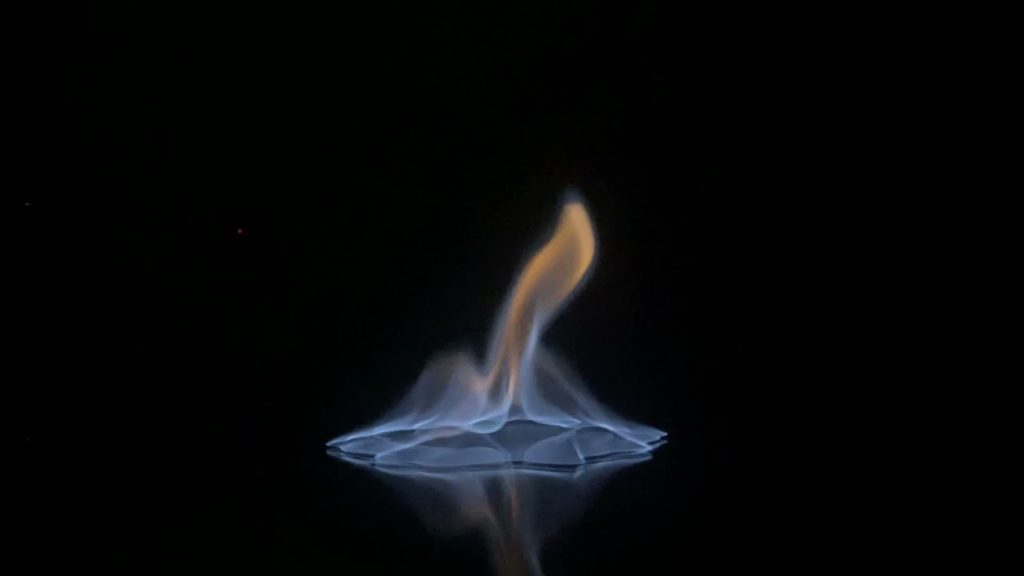Introduction
For my second image/video assignment I decided I really wanted to do something with fire. I remembered that in my past I used to take any type of hand sanitizer and light it on fire. By doing this, it creates a visual of blue and orange dancing flames. Since the hand sanitizer burns as a blue flame with no smoke, the flame appears almost invisible in light. However, when you turn off the lights you unleash the pure beauty of the potential energy in the hand sanitizer. By attempting this experiment multiple times I was finally able to capture this beauty in all of its essence.
Calculation/Research
In terms of the calculations/research portion of this assignment, there are a few things that we can digest. One subject that we can dive deeper into is the wavelength and frequency of the flame. If we pay close attention to my video we can see that my flame has a color gradient that goes from an icy blue to almost a sunshine yellow. With the diagram (via Wikipedia citation for diagram is in references) presented below we can identify the wavelength and the frequency of the flame.
We can see at the bottom of the combustion there is a blue flame. By looking at this chart we can approximate that our flame has a wavelength of 450-485 nm and a frequency of 620-670 THz. At the top of the flame we can see a flicker of yellow which represents a wavelength of 565-590 nm and a frequency of 510-530 THz. We can explain this phenomena by stating the fact that the hand sanitizer has a specific amount of potential energy. With a smaller wavelength leads to a higher frequency and with a larger wavelength leads to a smaller frequency. So at the bottom of our flame, it is blue because the wavelength is smaller but our frequency is much greater. The top of the flame is yellow because the wavelength is greater but our frequency is smaller.
The rest of the potential energy in the hand sanitizer will be released as heat. With a change in color comes a change in temperature. Cooler colors (i.e. violet, blue, cyan) are typically associated with hotter temperatures and warmer colors (i.e. yellow, orange, red) are associated with lower temperatures.
Finally in conclusion to our research, we can draw the conclusion that as each molecule in our hand sanitizer burns up, the amount of remaining potential energy results in a difference in color, wavelength and frequency. Looking back at my video, if we take a closer look at a single molecule in the flame, as the molecule releases its energy, the wavelength increases, changing the frequency which in return results in a lower temperature. This is why when we see a flicker of yellow at the top of the flame, the remaining potential energy is lower at the top of the flame than it is at the start of the flame.
Materials/Setup
The materials used in this experiment are very simple. For this experiment I used NatureWell advanced liquid hand sanitizer. I took the hand sanitizer and put a generous amount on a nonflammable surface; in my case a granite countertop. I took a BiC lighter and lit the hand sanitizer. I repeated this process multiple times in order to get the best lighting, angle and what I believed was the most aesthetically pleasing flicker of fire. The exact flickering of the fire cannot be replicated which makes it unique.
As for the camera details and setup, I decided to go with an iPhone 11 pro camera and took the photo in the portrait landscape. For the settings of the camera, the iPhone has limited variability so I used the default settings of the phone (settings of which are not very clear). The standard video settings on the iPhone 11 pro is 1080p 60fps. I set up the camera approximately one foot away to ensure that I captured the whole flame in the shot. As for the post editing, I did not need to do any. I personally believed that the flame was beautiful enough and did not need to be enhanced.
Conclusion
I think this video reveals the true beauty of something that can be so dangerous. When not in control, fire can be a dangerous subject. However, when you truly look at it and slow it down, you can truly appreciate all of its glory. I think that’s one of my favorite aspects of this video. From the flow to the colors, a fire is visually perfect. I think I perfectly captured this beauty; a beauty that not a lot of people really think about.
Though I think this video is nearly perfect, I believe there is one thing I wish I could do better. One thing that I wish I could do better is shoot the video in a higher quality that could perfectly capture the color gradients in the fire. Since a flame is so bright, the amount of light that is captured by the iPhone is too great. The excessive light leads to a slight over exposure of the flame, dwindling the full color gradient presented in the fire.
Though my video may not be perfect, overall, I am very impressed by the video that I captured. I think I perfectly covered my intent and was able to share the beauty that I see with the world.
References
“Visible Spectrum.” Wikipedia, Wikimedia Foundation, 23 Sept. 2021, https://en.wikipedia.org/wiki/Visible_spectrum.
[/vc_column_text][/vc_column][/vc_row]

1 Comment. Leave new
This is a very interesting video of a phenomenon I had never really thought much about in the past, and I really liked the way you captured it in this video with really good editing. Good job!